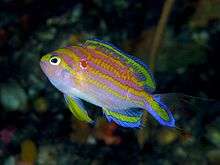Anthiinae
Anthias are members of the family Serranidae and make up the subfamily Anthiinae.[1] Anthias make up a sizeable portion of the population of pink, orange, and yellow reef fishes seen swarming in most coral reef photography and film. The name Anthiidae is preoccupied by a subfamily of ground beetles in the family Carabidae created by Bonelli in 1813 and this grouping should be called the Anthiadinae.[3][4] However, both the 5th Edition of Fishes of the World and Fishbase give the Serranid subfamily as "Anthiinae".[5][6]
| Anthiinae | |
|---|---|
 | |
| Tosanoides flavofasciatus | |
| Scientific classification | |
| Kingdom: | Animalia |
| Phylum: | Chordata |
| Class: | Actinopterygii |
| Order: | Perciformes |
| Family: | Serranidae |
| Subfamily: | Anthiinae Poey, 1861 [1][2] |
| Genera | |
|
See text | |
| Synonyms | |
|
Anthiadinae Poey, 1861 | |
Anthias are mostly small, thus are quite popular within the ornamental fish trade. They form complex social structures based on the number of males and females and also their position on the reef itself, and are mainly zooplankton feeders. They occur in all tropical oceans and seas of the world. The first species recognized in this group was described in the Mediterranean and northeast Atlantic and was given name Anthias anthias by Carl Linnaeus in 1758.
Anthias can shoal by the thousands. Anthias do school in these large groups, though they tend toward more intimate subdivisions within the school, appropriately called "harems". These consist of one dominant, colorful male, and two to 12 females — which have their own hierarchy among them — and up to two 'subdominant' males, often less brightly colored and not territorial. Within the swarm of females, territorial males perform acrobatic U-swim displays and vigorously defend an area of the reef and its associated harem.
Most anthias are protogynous hermaphrodites. These anthias are born female; if a dominant male perishes, the largest female of the group will often change into a male to take its place. This may lead to squabbling between the next-largest male, which sees an opportunity to advance, and the largest female, whose hormones are surging with testosterone.
Seven genera of anthias are known to occur in coral reef ecosystems: Holanthias, Luzonichthys, Nemanthias, Plectranthias, Pseudanthias, Rabaulichthys, and Serranocirrhitus. Members of all these genera make it into the aquarium trade, although Pseudanthias is by far the most encountered in the hobby.
Genera
The following genera are classified within the Anthiinae:[7][5]
- Acanthistius Gill, 1862
- Anatolanthias Anderson, Parin & Randall, 1990
- Anthias Bloch, 1792
- Baldwinella Anderson & Heemstra, 2012[8]
- Caesioperca Castelnau, 1872
- Caprodon Temminck & Schlegel, 1843
- Choranthias Anderson & Heemstra, 2012[8]
- Dactylanthias Bleeker, 1871
- Epinephelides Ogilby, 1899
- Giganthias Katayama, 1954
- Hemanthias Steindachner, 1875
- Holanthias Günther 1868
- Hypoplectrodes Gill, 1862
- Lepidoperca Regan, 1914
- Luzonichthys Herre, 1936
- Meganthias Randall & Heemstra, 2006
- Nemanthias J.L.B. Smith, 1954
- Odontanthias Bleeker, 1873
- Othos Castelnau, 1875
- Plectranthias Bleeker, 1873
- Pronotogrammus Gill, 1863
- Pseudanthias Bleeker, 1871
- Rabaulichthys Allen, 1984
- Sacura Jordan & Richardson, 1910
- Selenanthias Tanaka, 1918
- Serranocirrhitus Watanabe, 1949
- Tosana H.M. Smith & Pope, 1906
- Tosanoides Kamohara, 1953
- Trachypoma Günther, 1859
References
- Pyle, R.L., Greene, B.D. & Kosaki, R.K. (2016): Tosanoides obama, a new basslet (Perciformes, Percoidei, Serranidae) from deep coral reefs in the Northwestern Hawaiian Islands. ZooKeys, 641: 165–181.
- Richard van der Laan; William N. Eschmeyer & Ronald Fricke (2014). "Family-group names of Recent fishes". Zootaxa. 3882 (2): 001–230.
- Bailly, Nicolas (2018). "Anthiinae Poey, 1861". WoRMS. World Register of Marine Species. Retrieved 31 May 2020.
- Eschmeyer, W. N.; R. Fricke & R. van der Laan (eds.). "Anthiadinae genera". Catalog of Fishes. California Academy of Sciences. Retrieved 31 May 2020.
- J. S. Nelson; T. C. Grande; M. V. H. Wilson (2016). Fishes of the World (5th ed.). Wiley. pp. 446–448. ISBN 978-1-118-34233-6.
- Froese, Rainer, and Daniel Pauly, eds. (2019). "Serranidae" in FishBase. December 2019 version.
- Eschmeyer, W. N.; R. Fricke & R. van der Laan (eds.). "Serranidae genera". Catalog of Fishes. California Academy of Sciences. Retrieved 26 May 2020.
- Anderson, W.D. Jr.; Heemstra, P.C. (2012). "Review of Atlantic and Eastern Pacific Anthiine Fishes (Teleostei: Perciformes: Serranidae), with Descriptions of Two New Genera". Transactions of the American Philosophical Society. 102 (2): 1–173.